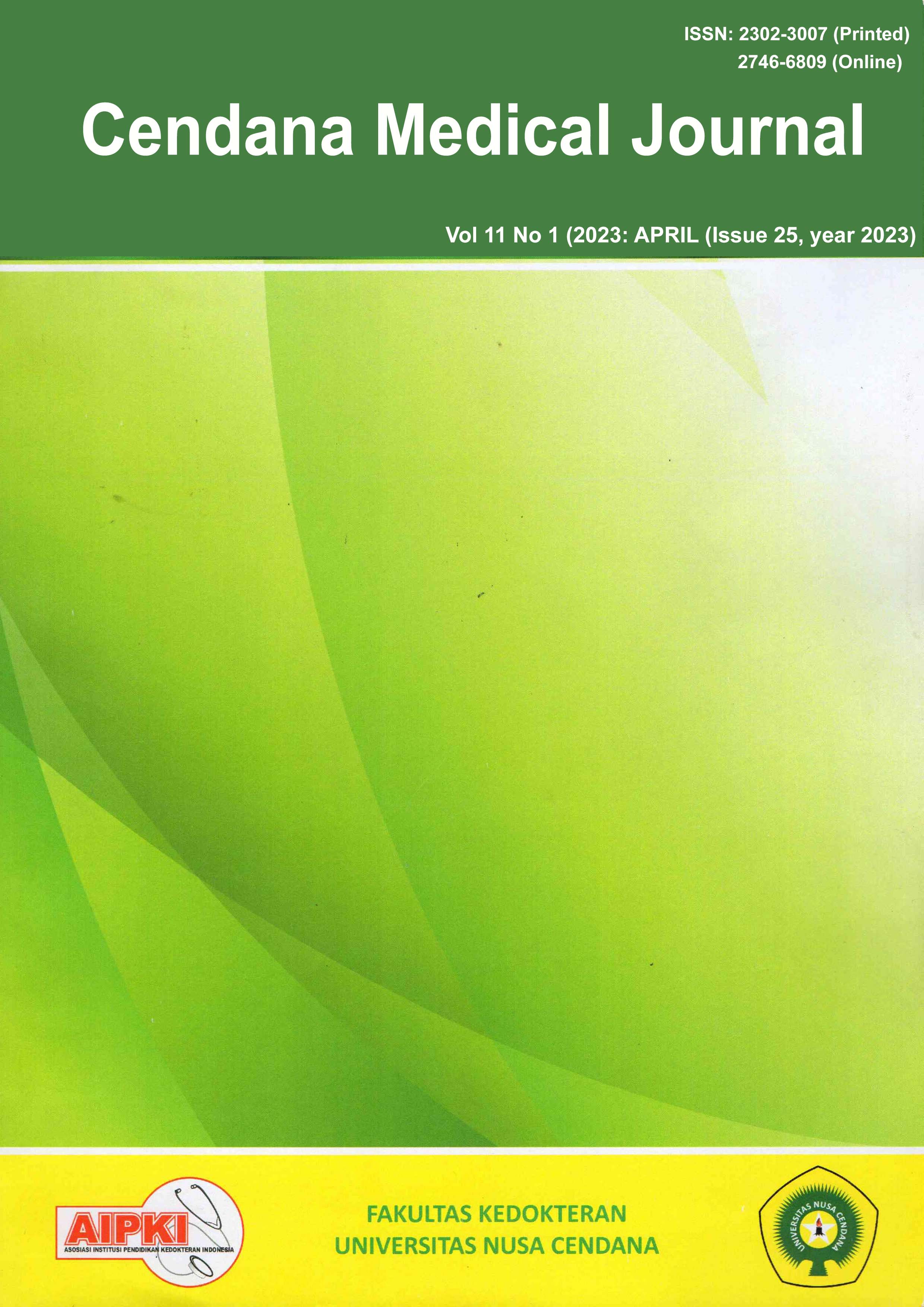Correlation Between Level Of Education And IUGR Incidence At Rsud Prof. Dr. W. Z. Johannes Kupang In 2021
Abstract
Intra Uterine Growth Restrictions (IUGR) are defined as fetal growth rates less than normal fetal growth potential for certain neonates or failure of the fetus to reach its growth potential. The greatest incidence of intrauterine growth restriction in developing countries is multifactorial and involves a complex collaboration of fetal, placental and maternal factors, although maternal factors are the predominant cause. The purpose of this study was to determine the relationship between education level and the incidence of IUGR at RSUD Prof. Dr. W.Z. Johannes Kupang. This research is a descriptive study using a retrospective cross-sectional method. Data collection was carried out in November 2022 - January 2023 at RSUD Prof. Dr. W. Z. Johannes Kupang, East Nusa Tenggara. Samples were taken by total sampling with the number 110 samples being the final smaples. The results of this study indicate that there is a relationship between education level and the incidence of IUGR. The value of each Pearson Correlation variable is 0.711 which means r count > from r table (0.245 with a significance value of 0.005). If the calculated r value is greater than the r table value, the Pearson Correlation analysis means that there is a correlation with these variables
Downloads
References
Battaglia FC, Lubchenco LO. A practical classification of newborn infants by weight and gestational age. J Pediatr. 2017;71(2):159–63.
de Onis M, Blössner M, Villar J. Levels and patterns of intrauterine growth retardation in developing countries. Eur J Clin Nutr. 2018;52(Suppl 1): S5–15.
Sharma D, Shastri S, Farahbakhsh N, Sharma P. Intrauterine growth restriction– part 1. J Matern Fetal Neonatal Med. 2016;7:1–11.
Hendrix N, Berghella V. Non-placental causes of intrauterine growth restriction.Semin Perinatol. 2008;32(3):161–5.
Serin S, Bakacak M, Ercan Ö, et al. The evaluation of Nesfatin-1 levels in patients with and without intrauterine growth restriction. J Matern Fetal Neonatal Med.2016;29(9):1409–13.
Laskowska M, Laskowska K, Leszczyńska-Gorzelak B, Oleszczuk J. Asym- metric dimethylarginine in normotensive pregnant women with isolated fetal intrauterine growth restriction: a comparison with preeclamptic women with and without intrauterine growth restriction. J Matern Fetal Neonatal Med.2021;24(7):936–42.
Sharma D, Shastri S, Farahbakhsh N, Sharma P. Intrauterine growth restriction– part 1. J Matern Fetal Neonatal Med. 2016;7:1–11.
Saki F, Dabbaghmanesh MH, Ghaemi SZ, Forouhari S, Ranjbar Omrani G, Bakhshayeshkaram M. Thyroid function in pregnancy and its influences on maternal and fetal outcomes. Int J Endocrinol Metab. 2014;12(4):e19378.
da Costa IT, Leone CR. Intrauterine growth restriction influence on the nutri- tional evolution and growth of preterm newborns from birth until discharge. Rev Paul Pediatr. 2019;27(1):15–20.
Royal College of Obstetricians & Gynaecologists. Small-for-Gestational-Age Fetus, Investigation and Management (Green-top Guideline No. 31) [Internet].2015.
Figueras F, Gratacos E. Stage-based approach to the management of fetal growth restriction. Prenat Diagn. 2014;34(7):655–9.
Oros D, Figueras F, Cruz-Martinez R, Meler E, Munmany M, Gratacos E.Longitudinal changes in uterine, umbilical and fetal cerebral Doppler indi- ces in late-onset small-for-gestational age fetuses. Ultrasound Obstet Gynecol.2017;37(2):191–5.
Alfirevic Z, Stampalija T, Gyte GML. Fetal and umbilical Doppler ultrasound in high-risk pregnancies. Cochrane Database Syst Rev. 2018;11:CD007529.
Cosmi E, Ambrosini G, D’Antona D, Saccardi C, Mari G. Doppler, cardiotoco- graphy, and biophysical profile changes in growth-restricted fetuses. Obstet Gynecol. 2015;106(6):1240 –5.
Yagel S, Kivilevitch Z, Cohen SM, et al. The fetal venous system, Part II: ultrasound evaluation of the fetus with congenital venous system malformation or developing circulatory compromise. Ultrasound Obstet Gynecol. 2020;36(1):93–111.
Mari G, Hanif F, Drennan K, Kruger M. Staging of intrauterine growth- restricted fetuses. J Ultrasound Med. 2017;26(11):1469–77. quiz 1479.
Figueras F, Gratacós E. Update on the diagnosis and classification of fetal growth restriction and proposal of a stage-based management protocol. Fetal Diagn Ther.2014;36(2):86–98.
Bhutta ZA, Das JK, Bahl R, et al. Can available interventions end preventable deaths in mothers, newborn babies, and stillbirths, and at what cost? Lancet.2014;384(9940):347–70.
Ota E, Hori H, Mori R, Tobe-Gai R, Farrar D. Antenatal dietary education and supplementation to increase energy and protein intake. Cochrane Database Syst Rev. 2015;6:CD000032.
Copyright (c) 2023 Cendana Medical Journal

This work is licensed under a Creative Commons Attribution-NonCommercial-NoDerivatives 4.0 International License.
Copyright Notice

This work is licensed under a Creative Commons Attribution 4.0 International License.

 Dewa Gede Agung Sasmara Putera(1*)
Dewa Gede Agung Sasmara Putera(1*)












